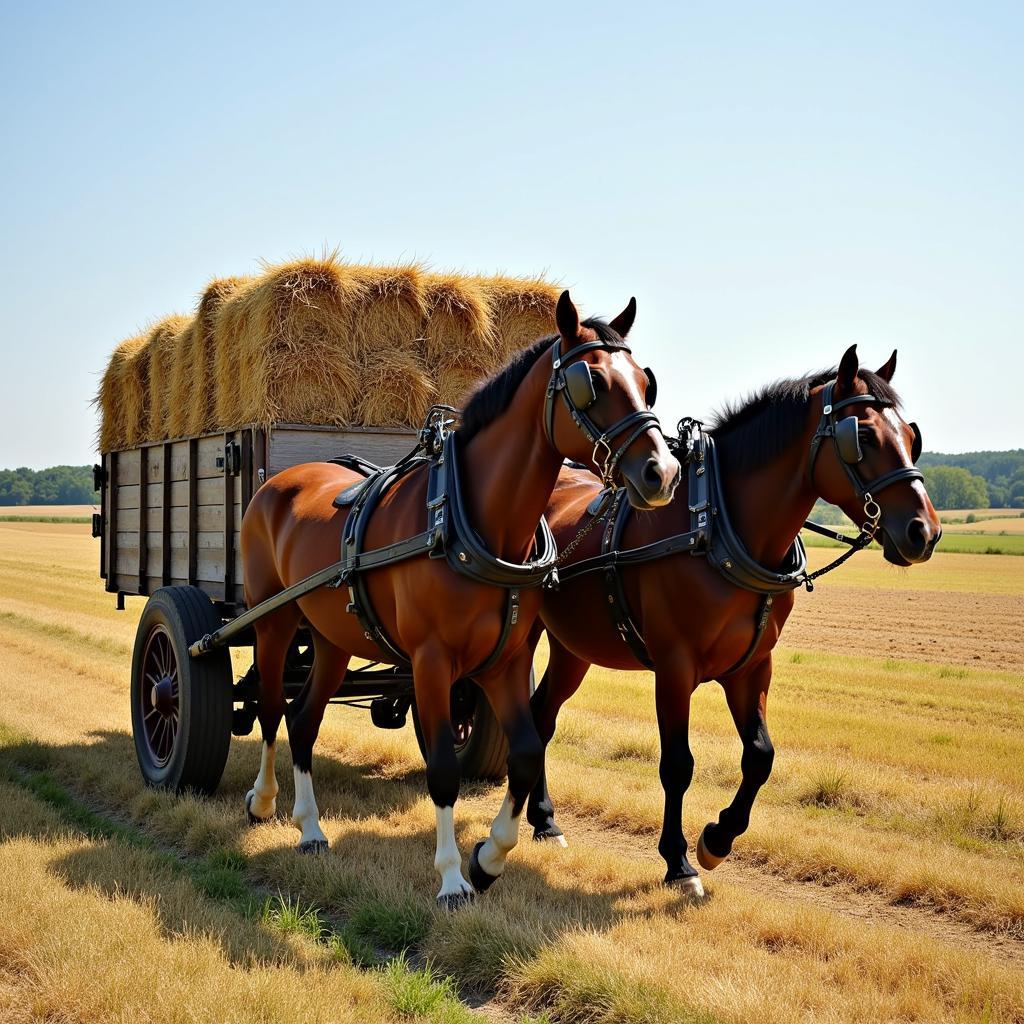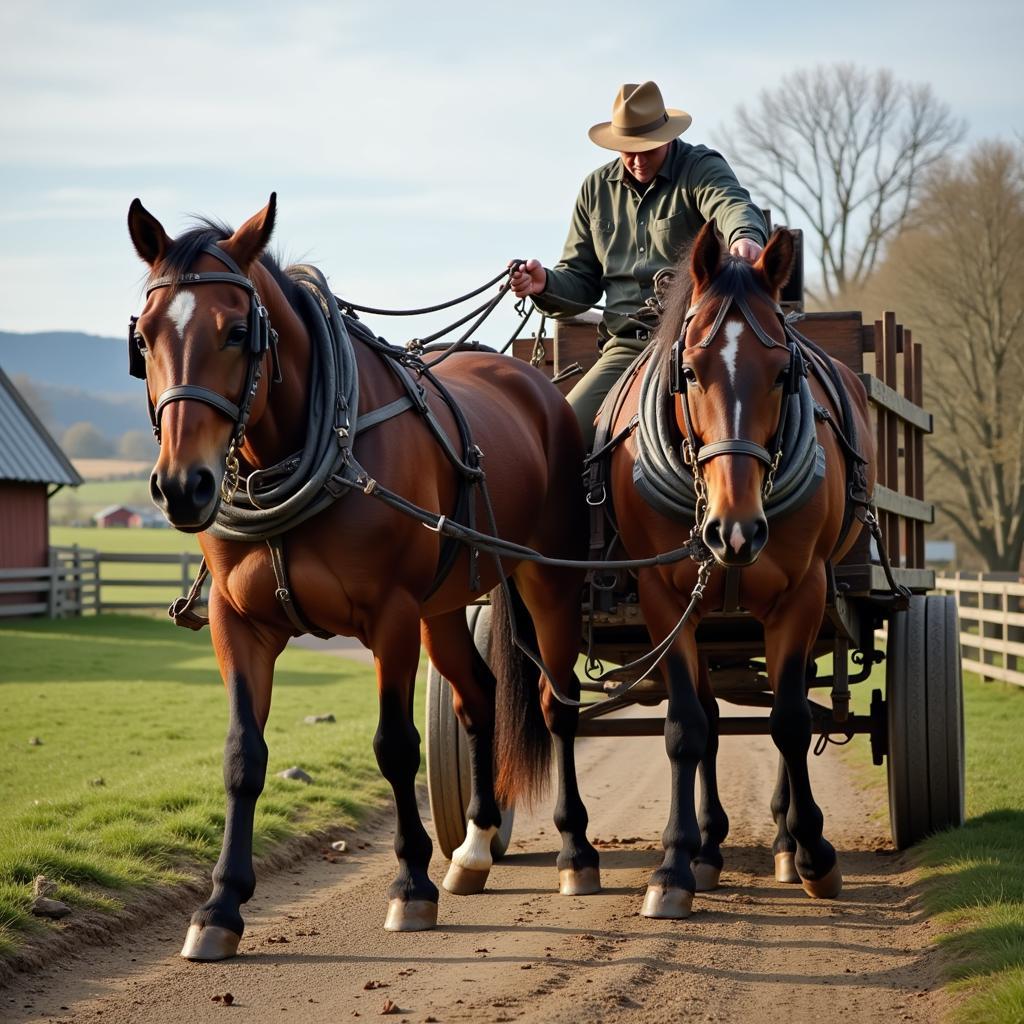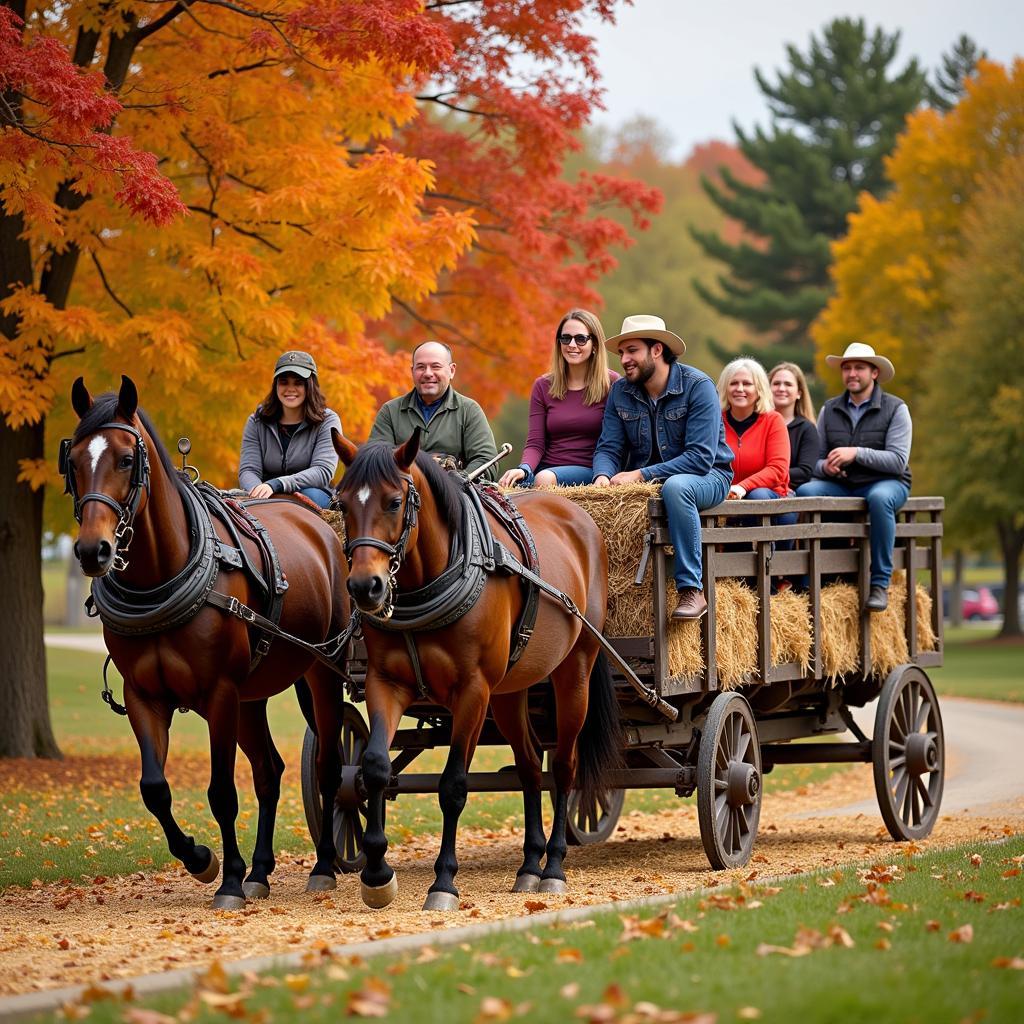The Horse Drawn Farm Wagon, a symbol of simpler times, evokes images of rolling hills, bountiful harvests, and the rhythmic clop of hooves. More than just a picturesque relic, these wagons hold a significant place in agricultural history and continue to capture the hearts of those who appreciate their enduring functionality and rustic beauty. This article delves into the world of horse drawn farm wagons, exploring their history, diverse types, practical uses, and the art of driving and maintaining them.
A Journey Through Time: The History of Horse Drawn Farm Wagons
From the earliest rudimentary carts to the sophisticated wagons of the 19th century, the evolution of the horse drawn farm wagon mirrors the development of agriculture itself. Initially, simple sledges and two-wheeled carts were used for transporting goods and produce. Over time, these evolved into four-wheeled wagons, enabling larger loads and smoother travel. The introduction of the spoked wheel and later, the iron-rimmed wheel, significantly improved the wagon’s durability and efficiency. The development of sophisticated braking systems and suspension further enhanced their functionality and comfort.
The 19th century witnessed a golden age for horse drawn farm wagons, with various designs catering to specific needs and terrains. Farmers relied heavily on these wagons for hauling crops, transporting livestock, and carrying essential supplies. The horse drawn farm wagon became an integral part of rural life, shaping communities and facilitating trade.
After the first paragraph, I’d like to delve into the different types of wagons. This will help our readers understand the variety and rich history behind these beautiful vehicles. Sarcoids in horses pictures can sometimes be seen on working farm horses, so it’s important to be aware of their health.
Types of Horse Drawn Farm Wagons: From Prairie Schooners to Freight Wagons
Different types of horse drawn farm wagons emerged to meet diverse agricultural needs. The Prairie Schooner, iconic for its role in westward expansion, was a lighter, covered wagon designed for long-distance travel. Freight wagons, sturdy and built for heavy loads, were essential for transporting goods over long distances. Farm wagons, designed for general use on the farm, came in various sizes and configurations, reflecting the specific needs of individual farmers. These versatile vehicles were adapted for various tasks, from hauling hay and grain to transporting livestock and equipment.
 Freight wagon transporting hay across a field
Freight wagon transporting hay across a field
The versatility of these wagons made them invaluable tools for farmers and played a crucial role in the development of agriculture. They represented not only a means of transport but also a symbol of hard work, resilience, and the close relationship between humans and animals.
Harnessing the Power: Driving and Maintaining a Horse Drawn Farm Wagon
Driving a horse drawn farm wagon is an art that requires skill, patience, and a deep understanding of horses. It involves more than just holding the reins; it’s about building a connection with the animal and understanding its cues. Proper harnessing and hitching are essential for the safety and comfort of both horse and driver. Knowing how to control the speed and direction of the wagon, especially on varied terrain, is critical.
Maintaining a horse drawn farm wagon involves regular cleaning, lubrication, and inspection of all parts, including the wheels, axles, and undercarriage. Regular maintenance ensures the wagon’s longevity and prevents costly repairs. Protecting the wooden components from weather damage is also crucial.
 Farmer hitching a horse to a farm wagon
Farmer hitching a horse to a farm wagon
Glaucoma in horses can affect their ability to pull wagons, highlighting the importance of equine health. Regular check-ups and preventative care are essential for maintaining the well-being of your working animals.
Modern Uses and the Enduring Appeal of Horse Drawn Farm Wagons
While tractors and trucks have largely replaced horse drawn farm wagons in modern agriculture, these timeless vehicles still hold a special place in many hearts. They are used for recreational purposes, historical reenactments, and even in some niche agricultural operations where their low impact and traditional charm are appreciated. The resurgence of interest in sustainable agriculture has also sparked renewed interest in these eco-friendly modes of transport.
 Horse drawn wagon hayride through autumn foliage
Horse drawn wagon hayride through autumn foliage
Horse drawn farm wagons represent a tangible connection to our agricultural heritage, reminding us of the ingenuity and hard work of past generations. Their continued presence, whether in museums, private collections, or working farms, serves as a testament to their enduring appeal and historical significance.
Conclusion: The Legacy of the Horse Drawn Farm Wagon
The horse drawn farm wagon remains a powerful symbol of agricultural history. From its humble beginnings as a simple cart to its refined form in the 19th century, it has played a vital role in shaping rural life. While modern technology has largely superseded its practical use, the horse drawn farm wagon continues to capture our imagination, reminding us of simpler times and the enduring bond between humans and horses. Preserving these historical treasures ensures that future generations can appreciate the legacy of the horse drawn farm wagon.
FAQ
- What is the average lifespan of a horse drawn farm wagon?
- What are the key differences between a Prairie Schooner and a freight wagon?
- What type of horse is best suited for pulling a farm wagon?
- Where can I find resources for learning how to drive a horse drawn farm wagon?
- Are there any modern manufacturers of horse drawn farm wagons?
- What are the typical maintenance requirements for a horse drawn farm wagon?
- How can I find a reputable source for purchasing a restored or antique horse drawn farm wagon?
Common Scenarios and Questions
- Scenario: You’re planning a wedding and want a horse-drawn wagon for a unique photo opportunity. Question: Where can I find a horse-drawn wagon for rent for special events?
- Scenario: You’ve inherited an old farm wagon and want to restore it. Question: What resources are available for restoring antique farm wagons?
- Scenario: You’re interested in learning more about the history of horse-drawn wagons. Question: Where can I find historical information and exhibits related to horse-drawn wagons?
Further Exploration
For more information on horse-related topics, you can explore our articles on sarcoids in horses pictures and glaucoma in horses. These resources offer valuable insights into equine health and care.
Contact Us
For any assistance or inquiries about horse-drawn wagons or other related topics, feel free to reach out. Call us at 0772127271, email us at justushorses@gmail.com, or visit us at QGM2+WX2, Vị Trung, Vị Thuỷ, Hậu Giang, Việt Nam. We have a 24/7 customer service team ready to assist you.